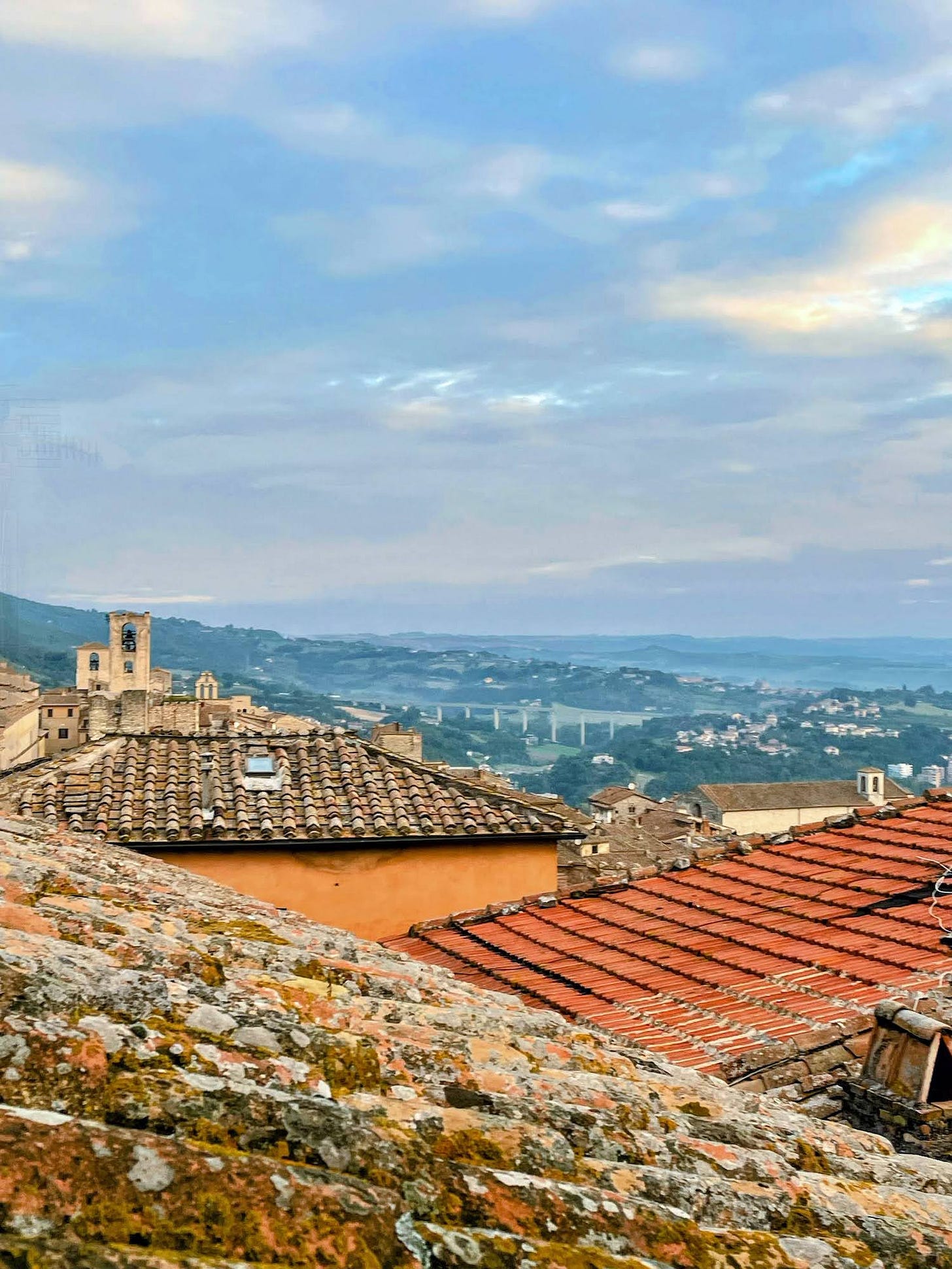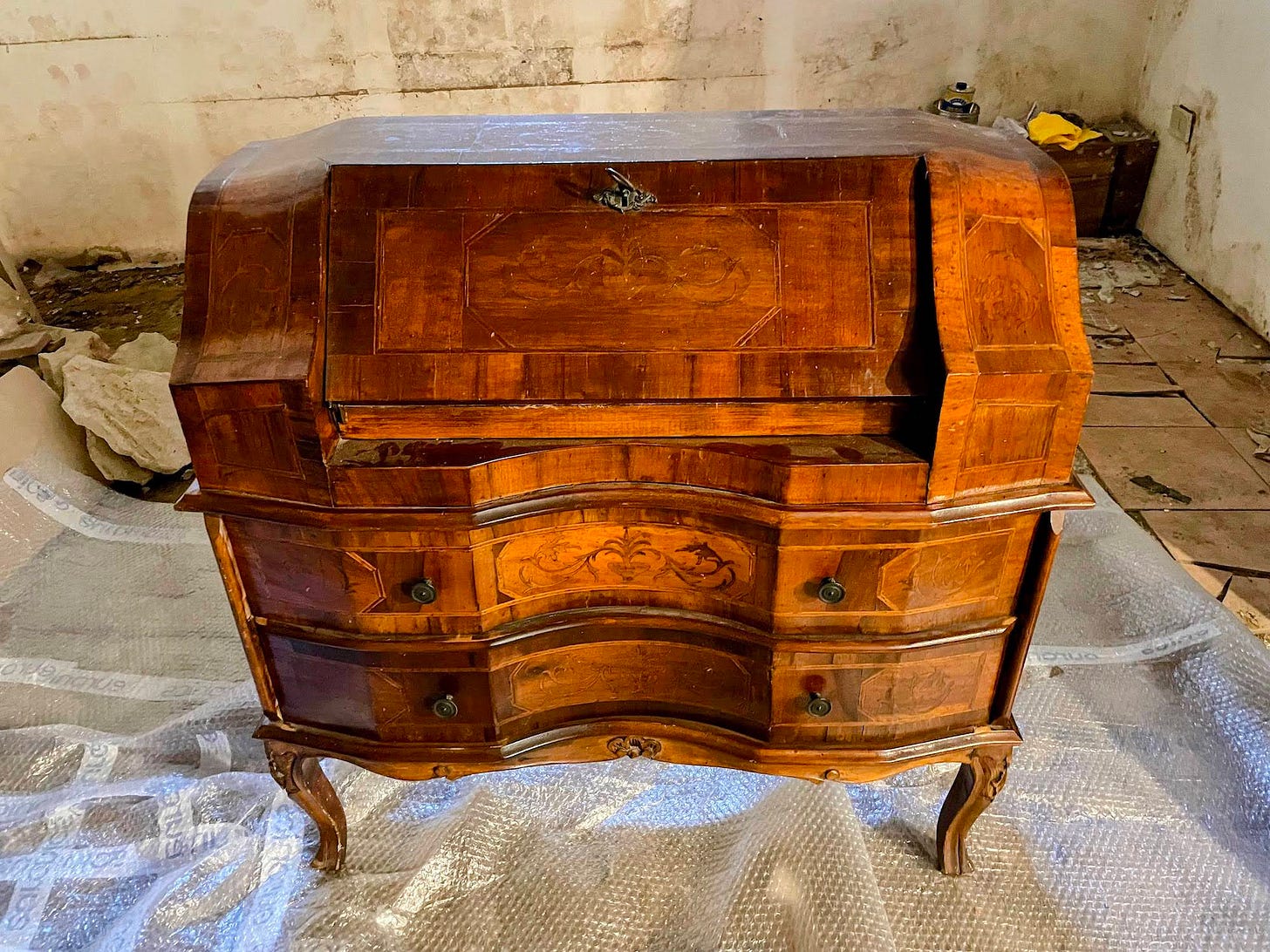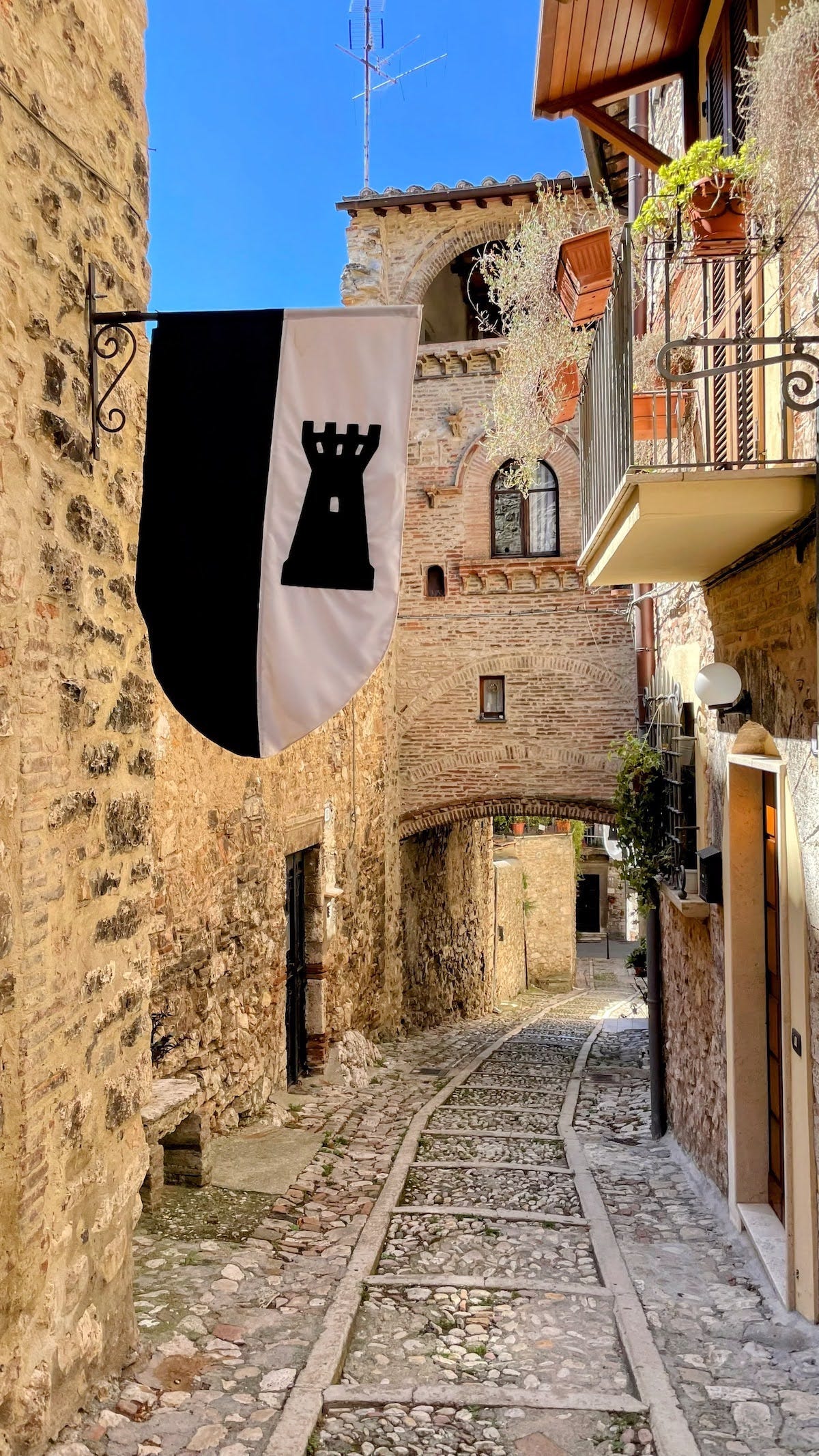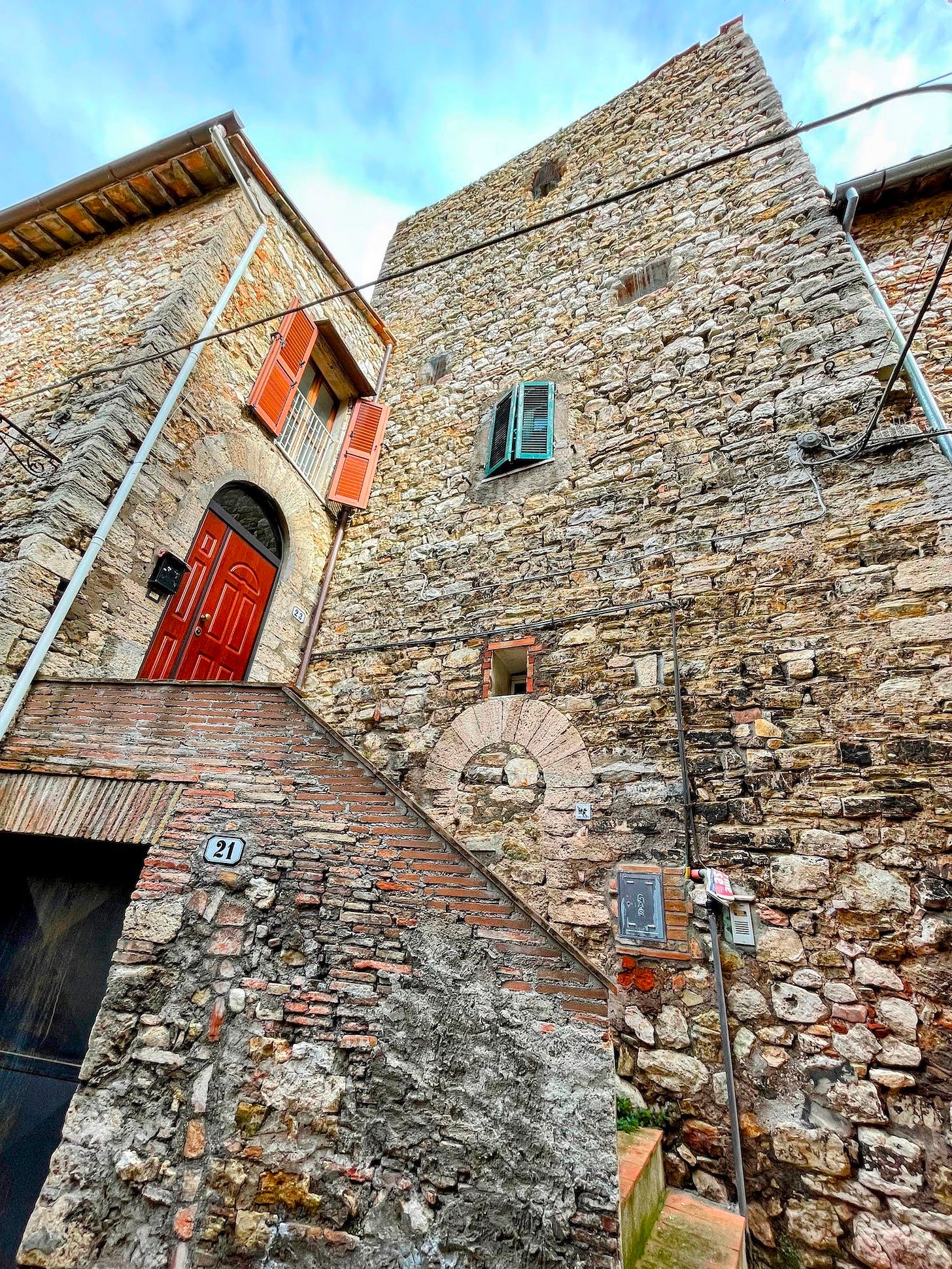The long, dark winter has finally passed: I have plane tickets to Italy! We will be spending the first glorious week of May in Narni. Which means we’re leaving in less than a month. It’s basically time to start packing now. I’m so excited!
While I would love to tell you I plan to spend my time mostly on cappuccinos in the piazza and sunsets over the Nera Valley, quite a number of other activities will require my attention as well. A few things on the to-do list for this trip:
-Take a look at fixes on the house/bookshop. One of the joys of owning a (very) old house in Italy is that life is full of surprises.
For instance, your boiler turns out to be thirty years old and only makes hot water, doesn’t heat the radiators. Which we did not even notice, because we bought the house in July, and it was so hot in Umbria in July that we didn’t think to try to turn on the heat (especially since the hot water obviously worked!).
In case you’re wondering, thirty years is old enough that parts for this model are no longer even available, which means—you guessed it—a new boiler.
On the upside, this also turned out to be an opportunity to replace it with a bigger boiler that will manage to heat both the house AND the bookshop downstairs. So someday when you visit in the dead of winter, we’ll be able to sit down together in comfy chairs in a cosy, warm bookshop and enjoy a cup of tea together. I’m calling this one a win.
Or how about this surprise: finding out your roof is missing tiles, and leaking into your living room and the neighbours’ house as well. Which of course causes you to imagine worst-case scenarios, up to and including black mould acquiring sentience within the walls. Or do I read too much?

Did we at any time while we were trying to address these issues long-distance from another country in a language we barely speak, regret buying the most charming stone house in Italy? Not for a moment!
Alright, for a moment.
But everything is fixed now, so all we need to do is inspect the repairs and check if there are any other glaring issues in need of attention. We are incredibly lucky to have wonderful friends and lovely neighbours in Narnia, who helped us manage both these little disasters. We can’t wait to thank them in person.
-Check on a (gasp) woodworm infestation. Bookshop nightmare!!! This unfortunate situation came about because I am determined to source all the bookshop furniture locally, and secondhand. I rhapsodised a few months ago about the wonderful secondhand shops in Italy, which we must have visited at least half a dozen times in the space of two weeks last September.
During one of those visits, I acquired this delicious little secretary desk.

Is this desk not the cutest thing you have ever seen, and worthy of storing all the paperwork and other sundries necessary for running a bookshop? I also imagine myself drafting novels at this desk, not to mention writing ever more inspired pieces for Escape to the Bookshop.
However. It was only after bringing it home and making a space for it in my bedroom in Italy that I looked more closely at the delicate carved feet and noticed with disquiet a few small, round holes. Just little imperfections in the wood, I told myself. Nothing to worry about. Natural material, probably almost a hundred years old. Etc., etc.
Can you tell I’m a bit of a novice when it comes to antique furniture?
Closer inspection around the undercarriage of the desk revealed several dozen more of these holes, which Google unfortunately confirmed to me were in fact almost certainly woodworm holes.
At which point I may have had just a tiny breakdown.
Fortunately, I have a friend in Amsterdam who has experience with this sort of thing. She assured me that woodworm problems are not the end of the world, nor a reason to throw out furniture you’ve only just acquired but are already hopelessly in love with and can’t imagine living without.
She sent me to the hardware store to buy a permethrin-based insecticide specifically formulated for woodworm (antitarlo—a useful new vocabulary word), a pair of rubber gloves, a syringe with a needle, a paintbrush, and some small metal bowls.
I banished myself and the poor desk down to the (future!) bookshop (currently an unfinished cellar) and spent at least an hour painstakingly injecting antitarlo into each and every woodworm hole. Then I painted the entire surface of the desk with antitarlo (except the desktop, since it’s far from the—possibly old and inactive—infestation, and I don’t want to be touching antitarlo every time I sit down to write). Finally, for good measure, I set each desk leg in a small bowl of antitarlo, which my friend said would kill any fleeing woodworms. And then wrapped the whole thing up in leftover bubblewrap from our new couch, so they couldn’t escape by flying, which was probably overkill, but I was paranoid.
Just to let you know how freaked out I was, I am normally not a person who gravitates toward harsh chemicals or pesticides. I clean my house with vinegar and Castile soap, and every summer I battle the ants that invade my ground-floor Amsterdam apartment with marginally effective lines of baking soda and occasional sprays of vinegar to disrupt their pheromone trails.
(If you know of a better natural deterrent to invading ants, please enlighten me!)
In the case of the desk, I didn’t feel I could take chances, considering the horrifying possibility of infecting an entire bookshop with woodworms. Can you imagine?
(Don’t worry, the books are not yet in the bookshop, or even in Italy. They are in my house in Amsterdam, as well as overflowing into a storage unit we’ve already upgraded twice to accommodate my insatiable tsundoku.)
I still have an occasional Kafka-esque dread fantasy of a giant mutated woodworm confronting me in a towering rage of poetic justice when I open the bookshop door next month to check on the desk. Wish me luck. And if I suddenly disappear, well, you’ll know what happened.
OK, back to that to-do list (and things look up from now on, I promise!):
-Go to Narni’s city festival, The Corsa all’Anello. Like many small (and not so small) towns in Italy, Narni has an annual city festival, and it is a Big Deal.
Many of these festivals revolve around a traditional food or agricultural product from the town. For instance, Lagnasco—the little town in Piemonte where Tony’s great-great grandfather Domenico was born in 1826—is surrounded by apple, peach, pear, and other orchards. So theirs is a spring festival called “Fruttinfiore” (Fruit in flower). It happens in April, when all the trees are in bloom.
Chiusa di Pesio—the town on the edge of the Alps where we applied for (and got) Italian citizenship, and therefore have all our birth certificates recorded—hosts a Polentata in late summer. Yes, around the time of the corn harvest. They set up long tables in the centre of town, and everyone feasts on polenta.
Cuneo, the next big town over, where we would go for the weekly market day, celebrates an autumn chestnut festival, the Fiera Nazionale del Marrone. It’s in mid-October, so you can buy fresh, hot, roasted chestnuts from vendors all up and down the street, or marrons glacés (candied chestnuts) in fancy little boxes.
Way back in the late 2000s when we lived there, I remember walking down a long, shady avenue lined in chestnut trees on the way to the fair, and wondering why so many beautiful, shiny brown chestnuts had been left lying on the ground. Giddy at the bounty, I filled my backpack with at least two kilos of chestnuts. We enjoyed the fair, and then I took my foraged treasure home.
The next day, I pulled out a chestnut soup recipe I’d been eyeing in my favourite cookbook. How European! How sophisticated. I was about to make creamy, delectable chestnut soup. I imagined myself spooning soup out of fine china in Downton Abbey, or overwintering with my chestnut soup in a cosy mole hole in The Wind in the Willows.
The recipe was more involved than anything I would normally cook as a busy mom of two toddlers, but I knew it would be worth it: “nutty and slightly sweet, with a hint of nutmeg,” my cookbook promised. Dinnertime neared, and my soup was finished simmering. I raised a spoonful to my lips. Time to taste.
So bitter! Wait. Could this be right? I was barely able to choke down one bite. I’d followed the recipe so exactly. What could I possibly have done wrong?
Well. What, indeed. Have you ever heard of horse chestnuts? Probably, you have. I hadn’t. Or maybe I’d heard the name, but I was no expert in the subtle nuances of chestnut varieties. Truth be told, I hadn’t given it much thought. Chestnuts are chestnuts are chestnuts, right?
Wrong. Turns out anyone with even a cursory knowledge of chestnuts could have told me (had I thought to ask) that horse chestnuts aren’t real chestnuts; they’re not even related. They’re also not edible. In fact they’re classed as “mildly poisonous.” In other words, don’t try this at home.
Don’t worry: I didn’t feed any to my children. And one bite of inedible soup turned out not to be enough to poison me. I did, however, learn my lesson: If you’re at the chestnut festival, and everyone else is buying chestnuts instead of picking them up off the ground, don’t assume you’re the clever one.
These days, I like to do a bit of research before showing up for a festival, to avoid faux pas and poisonings.
Narni’s festival is about history, not food (though of course, this being Italy, there’s plenty of good food on offer in Medieval-style taverns that open only during the festival).
Corsa all’Anello (Race of the Ring) is a full-on reenactment of Medieval festivities in honour of the city’s patron saint, Saint Juvenal. Established by city statute in 1371, and then resurrected in the mid-20th century, the three-week festival includes everything from dancing and juggling to a Medieval arts and crafts fair.
There’s a grand historical procession through torchlit streets, and all kinds of related workshops. But the pièce de résistance is a Medieval-style horseback race where you have to thread an honest-to-goodness knightly lance through a ring at full gallop. The knights are the champions of each of the three terzieri (which are like quarters of the city, only Narni is small, so it’s only divided in thirds).
Our house is in Mezule, the terziere of the city that runs from Piazza Garibaldi all the way up to the La Rocca di Albornoz, the fortress on the hill. Below, you can see the Mezule symbol and colours. Very high on my priority list for this trip is acquiring a banner like this to hang from my window!

The tower symbol is meant to evoke La Rocca, and the city fortress is indeed characterised by fine towers. But I also like to think of it as evoking my very own Medieval tower.

This will be my first time at Corsa all’Anello, although I’ve heard a lot about it. Narni even has a whole museum to give you a taste of the festival in case you visit at some other time of year. I’m so excited to experience it in person! And of course I’ll be sure to take lots of photos, so I can give you a flavour of what it’s like to be in Narni in the fourteenth century.





Sarah, it all sounds like the perfect place to write! And take pictues, and eat, and....you get the picture! LOL! I love shopping in second-hand shops. I can just imagine what you will find in Italy! I watch some YouTubers who live in and are restoring old castles and homes, in France and Italy...and they sometime bring us to brocantes in France and mercatino dell'usato in Italy. I sometimes pause the video just so I can really look around! So much amazing, old stuff to fill a house, or a bookstore! ;-) That desk is amazing! Just make sure that when you buy wood furniture to give it a treatment, even as prevention. So, I will be living vicariously through your posts here on SubStack! Looking forward to reading more, and hopefully seeing more beautiful pictures from the area! Ciao!
The views from your home in Narni are an absolute dream! There are few things as thrilling as finding the perfect piece of antique furniture, so I definitely understand your determination to save that writing desk - it's too perfect. Adding a visit to your future bookshop to my list of travels!